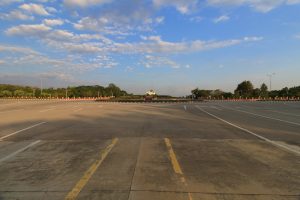Sebastian Strangio

Resistance forces in Myanmar have launched audacious drone attacks on the capital Naypyidaw, the nerve-center of the military junta, though opposition and military sources offered differing accounts of the attack.
Reuters cited a report from the military-run Myawaddy TV station claiming that an attempt by “terrorists” to destroy “important locations” in Naypyidaw had been foiled. The report claimed that 13 fixed-wing drones were shot down, four of which were carrying explosives.
In contrast, the opposition National Unity Government (NUG) claimed the drone assault was a strategic and political success. In a statement yesterday, the NUG’s Ministry of Defense said that special units of the People’s Defense Force (PDF), a loose alliance of anti-junta militias with which it is affiliated, used drones to attack targets across the sprawling, purpose-built capital in central Myanmar.
In the statement, the Ministry’s Permanent Secretary Naing Htoo Aung said that 30 drones were used, and that the targets included the Aye Lar Airbase, the headquarters of the State Administration Council, the junta’s ruling body, and the home of junta leader Senior Gen. Min Aung Hlaing.
“They have spent millions of dollars on a complex defense system, including air defenses. It is the place where the military council assumed no attack could happen,” he said, according to Reuters’ translation of Naing Htoo Aung’s comments. “That this three-year-old defense force was able to attack that kind of place shows a big step forward in the revolution.”
The attack was reportedly carried out by the Kloud Team (Shar Htoo Waw), a PDF unit that specializes in drone warfare, often using civilian drones fitted with explosives, as seen in this video posted to YouTube. It did so under the NUG Defense Ministry’s instructions, though further operational details were lacking.
It is unclear if there was any significant damage from the attacks, which employed kamikaze drones designed to explode on impact with the targets. As The Associated Press reported, photos released by the military administration showed only what appeared to be crashed drones. But the political significance of Myanmar’s opposition forces bringing the fight to the epicenter of the military’s power cannot be underestimated.
The attack comes after a string of reversals for the military junta, first in northern Shan State, where a coordinated offensive by the Three Brotherhood Alliance of ethnic armed groups scored rapid gains against junta positions, seizing the strategically important Kokang region from a military-aligned Border Guard Force. Then, since the start of this year, the military has suffered significant losses in Rakhine State in the country’s west, as the Arakan Army (AA), one member of the Brotherhood, went on the offensive. As the International Institute for Strategic Studies wrote in a recent briefing, “the AA’s sweeping gains are already enough to enable self-rule over a large portion of the Rakhine homeland and to reshape the wider balance of power in Myanmar.”
While the fall of Naypyidaw does not appear imminent, the fact that even the skies above the capital are no longer secure is a striking display of how the balance of forces is shifting across Myanmar. Indeed, the progress of Myanmar’s civil war since the military coup of February 2021 has brought conflict to the country’s central dry plain in a manner not seen since the early years after independence in 1948. As NUG spokesperson Kyaw Zaw told Reuters, “With this attack on their nerve center, Naypyidaw, we want to highlight that they don’t have a safe place.”AUTHORS
No comments:
Post a Comment